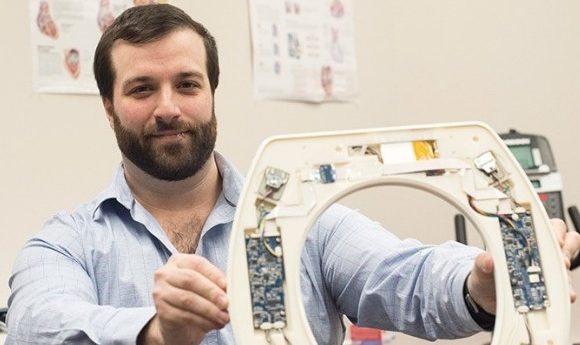Toilet seat that sniffs out heart disease

Nicholas Conn with the device. Credit: Rochester Institute of Technology (RIT, NY, USA).
A new toilet seat for people living with congestive heart failure could detect changes in the conditions of patients before they become symptomatic.
Congestive heart failure strikes over 550,000 new Americans each year, with a total of nearly 5 million currently living with congestive heart failure. Once diagnosed, re-admission rates are high and costs hospitals a vast amount of money. However, a toilet seat designed by a team of researchers from RIT could be about to change that.
“Typically, within 30 days of hospital discharge, 25 percent of patients with congestive heart failure are readmitted,” explained Nicholas Conn, post-doctoral fellow at RIT and CEO of Heart Health Intelligence (NY, USA). “After 90 days of hospital discharge, 45 percent of patients are readmitted. And the Centers for Medicare and Medicaid Services is penalizing hospitals for readmitting patients for heart failure.”
This re-admittance rate puts a strain on hospital funds, costing US$500,000 per year for just 150 patients, and can be dangerous for patients by causing concern and putting pressure on their lives. To address this issue the researchers decided to explore ways of monitoring a patient’s heart condition from the comfort of their own home. This would allow them to intervene in a patient’s treatment before their heart condition deteriorated to a point where they needed to be expelled from their homes and readmitted to hospital.
Conn and his team designed a toilet seat that can monitor the electrical and mechanical heart activity, along with heart rate, blood pressure, blood oxygenation and stroke volume. After downloading this data, algorithms can analyze it and, subject to further development, will be able to deliver the payload of data to cardiologists, alerting them of the patient’s change in condition. The cardiologist could then intervene early, such as a change in prescriptions or a swift drop-in office visit, that would be less dramatic and costly than a hospital admission.
The cost of administering 150 patients with a toilet seat would come to US$200,000 potentially saving hospitals a windfall of US$300,000 per year, if the seats bring re-admittance down to 0%.
The next step for the research team is to secure additional funding and FDA approval, while human-subject testing and pre-clinical trials are currently being conducted.





